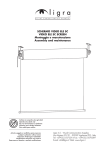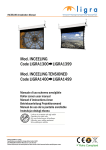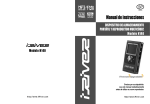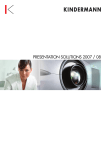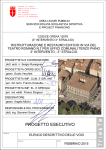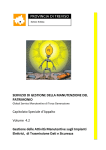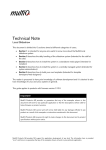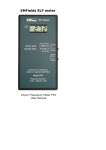Download 29020 Vigolzone (PC) - Italy Tel: +39-0523.872014 Fax: +
Transcript
COBRA ECOROLL / CINEROLL Manuale d’istruzione User manual/ CINEROLL ECOROLL Manuel d’instruction Betriebsanleitung Manuale d’istruzione Userusuario manual Manual de Manuel d’instruction Betriebsanleitung Manual de usuario Istruzioni d'uso e manutenzione schermi motorizzati “COBRA” con salita dal basso “COBRA” motorized screens use and maintenance guide Attenzione L’utilizzo è consentito solo agli adulti Operation by adults only Utilisation pour adultes seulement Nur von Enwachsenen zu bedienen Solo usable para adultos Attenzione 10.06.2009 Articolo soggetto a modifiche senza preavviso Ligra S.r.l. - Visual Communication Supplies Ligra S.r.l. - Visual Communication Supplies Eventuali modifiche saranno relizzate senza darne preavviso Subject to alteration without notice Via Artigiani 29/31 - 29020 Vigolzone (PC) - (PC) Italy Via Artigiani 29/31 - 29020 Vigolzone - Italy Modifications techniques sous réserve Tel: +39-0523.872014 Fax: +39-0523.870089 Tel: +39-0523.872014 Fax: +39-0523.870089 E-mail: [email protected] Web: www.ligra.it Technische Änderungen vorbehalten Reservamos el derecho a realizar modificationes E-mail: [email protected] Web: www.ligra.it 1) GUIDA UTENTE Vi ringraziamo per averci accordata la Vs. preferenza nell'acquisto di uno schermo motorizzato LUXI. Vi preghiamo di leggere attentamente queste istruzioni, onde procedere a corretta installazione, utilizzo e manutenzione dello schermo. 2) CARATTERISTICHE GENERALI DEL PRODOTTO Questo schermo è stato costruito in conformità con le disposizione delle relative normative CEE: direttiva bassa tensione 73-23 CEE, compatibilità elettromagnetica 89-336 CEE. Tutte le tele di proiezione utilizzate sono certificate ignifughe. Il grado di resistenza al fuoco e la relativa classe di classificazione varia in base al tipo di tela da proiezione utilizzata. Questo schermo è stato studiato da tecnici con lunga esperienza nel settore e viene costruito secondo standard elevati di qualità. Se lo schermo viene usato seguendo le istruzioni contenute nel presente manuale, oltre che lavorare con la massima efficienza, Vi garantirà anche una sua maggior durata. NORME DI SICUREZZA PER LA MANUTENZIONE: Seguire le norme di manutenzione riportate in questo libretto. Non effettuare riparazioni con la macchina in movimento. Utilizzare pezzi di ricambio originali. CRITERI DI SICUREZZA ADOTTATI: I cavi elettrici in dotazione sono contenuti in un'unica guaina di materiale plastico autoestinguente. Dispositivo termico elettrico di intervento nel caso di surriscaldamento del motore elettrico. ITALIANO 3) NORME GENERALI DI SICUREZZA Per usare lo schermo o fare manutenzione leggere attentamente le seguenti norme. Le istruzioni riportate in questo manuale non sostituiscono ma integrano gli obblighi per il rispetto della legislazione vigente di sicurezza e infortunistica. PRIMA: Leggere le istruzioni di preparazione della macchina. Controllare tutte le protezioni della macchina e sostituire immediatamente le parti danneggiate con ricambi originali. Leggere attentamente il manuale d'uso e manutenzione. DURANTE: Fare attenzione alle parti elettriche in tensione ed alle parti in movimento. DOPO: Togliere tensione con l'interruttore generale 4) GARANZIA La ditta costruttrice assume la garanzia del funzionamento del prodotto per la durata di 12 mesi per le parti meccaniche e di 5 anni per il motore elettrico, con decorrenza dalla data di consegna indicata sulla relativa bolla di accompagnamento. La garanzia è limitata alla sostituzione dei pezzi guasti o difetti dipendenti dalla costruzione e non contempla comunque la sostituzione del prodotto. Essa non si estende ai difetti causati dal consumo naturale o da imperizia o negligenze del committente, ai pezzi che per la composizione del materiale o la natura di impiego siano soggetti a rapido deterioramento e agli utensili di corredo. I guasti o difetti che si dovessero riscontrare devono essere comunicati per iscritto entro otto giorni dal ricevimento, pena la decorrenza della garanzia. La ditta costruttrice, previo accertamento del difetto, sostituisce gli elementi difettosi, purché non siano stati manomessi per tentata modifica o riparazione da parte del committente e questi abbia ottemperato agli obblighi contrattuali. E' espressamente escluso ogni altro indennizzo. In caso di parti installate in un secondo tempo, la garanzia copre soltanto tali parti con le stesse modalità sopra riportate. Le spese di spedizione, trasporto e manodopera sono a carico del cliente. Eventuali danni derivanti dal trasporto devono essere immediatamente comunicati al trasportatore, pena la decadenza della garanzia. 5) IMPORTANZA DEL MANUALE Il presente manuale contiene la descrizione dello schermo “Fenix”, si riferisce al suo uso, alle caratteristiche tecniche, funzionali, prestazioni e alle istruzioni di uso e manutenzione. Il manuale deve essere considerato parte integrante della macchina e deve essere custodito per tutta la sua durata e seguirla nel caso fosse ceduta a terzi. DESTINATARI DEL MANUALE Questa pubblicazione si rivolge: • al personale addetto all'installazione; • all'operatore; • al personale addetto alla manutenzione. CONSERVAZIONE DEL MANUALE Il manuale deve essere utilizzato in modo da non danneggiarne il contenuto. Non asportare, strappare o riscrivere per nessun motivo parti del manuale. Nel caso vi fosse questa necessità inserire dei fogli complementari. Conservare il manuale in luogo idoneo, protetto da umidità e calore affinché esso risulti sempre disponibile per la consultazione nel miglior stato. MODIFICHE ED INTEGRAZIONI Il manuale rispecchia lo stato dell'arte al momento dell'immissione sul mercato del prodotto del quale è parte integrante. Eventuali modifiche, miglioramenti, adeguamenti che venissero apportati al prodotto commercializzato successivamente, non obbligano il costruttore ad intervenire sul prodotto fornito precedentemente, ne a considerare lo stesso ed il relativo manuale carenti ed inadeguati. E' comunque facoltà del costruttore, quando lo ritenessero opportuno, e per qualificati motivi, aggiornare i manuali già presenti sul mercato, inviando ai propri clienti i fogli di aggiornamento che devono essere conservati nel manuale. 7) COSA FARE SEMPRE / COSA NON FARE MAI COSA FARE SEMPRE • seguire le indicazioni e le istruzioni riportate nei manuali di installazione e verificare l'integrità dei componenti della macchina; • rispettare le istruzioni e gli avvertimenti evidenziati sulla macchina; le targhe di avvertimento devono essere perfettamente leggibili; • testare la funzionalità dei pulsanti di comando. COSA NON FARE MAI • modificare, strappare le regolazioni dei dispositivi di sicurezza e/o provocare manomissioni dell'apparecchio; • eseguire riparazioni provvisorie o interventi di ripristino non conformi alle istruzioni; • utilizzare la macchina o far eseguire operazioni per la quale non è stata progettata; • utilizzare la macchina per fini diversi da quelli per i quali è stata progettata; • coprire, manomettere o asportare anche parzialmente le etichette posizionate sulla macchina. 8) INSTALLAZIONE ED UTILIZZO DELLO SCHERMO Rimuovere le fascette di blocco solo ad installazione avvenuta. Azionare lo schermo sempre dal davanti e mai da dietro. Prestare attenzione che le mani siano sempre lontane dai meccanismi mentre lo schermo è in movimento. Assicurarsi che lo schermo sia installato su un piano perfettamente orizzontale e non inclinato. Assicurarsi che non sia presente nessun ostacolo lungo tutta la corsa dello schermo. Prima di collegare lo schermo all'impianto controllare che il voltaggio della rete corrisponda a quello dello schermo. Connettere lo schermo ad una presa di corrente dotata di messa a terra. Lo schermo può essere dotato di interruttore o di trasmettitore, entrambi a due tasti distinti per la salita e la discesa. Premere il tasto “salita” per l'apertura del telo, il rilascio del pulsante provoca l’arresto della salita. Tenendo premuto il pulsante il telo si svolge tutto fino a fermarsi per l’intervento di un fine corsa. Terminato l’utilizzo per riavvolgere lo schermo, premere il tasto “discesa”, il rilascio del pulsante provoca l’arresto della discesa. Tenendo premuto il pulsante il telo si avvolge tutto fino a fermarsi per l’intervento di un fine corsa. In tali fasi porre particolare attenzione ai bracci in movimento. Non modificare mai i finecorsa di salita e discesa preimpostati. 9) MANUTENZIONE L’operazione di manutenzione deve essere effettuata togliendo l’alimentazione elettrica alla macchina. Lo schermo non necessita di alcuna operazione di manutenzione particolare: solo normale pulizia. PARTI MECCANICHE: spolverare utilizzando un panno morbido pulito, non colorato ed eventualmente dei detergenti non aggressivi . Prestare particolare attenzione ai punti di snodo dei bracci. TELO DI PROIEZIONE: utilizzare un panno morbido pulito ed inumidito eventualmente con liquido antistatico per recuperare la polvere, evitando di passare sui bordi neri. 10) UTILIZZO DOPO LUNGO PERIODO DI STOCCAGGIO Occorre accertarsi innanzitutto delle condizioni di stoccaggio del materiale: • se è stato protetto adeguatamente; • se è sempre stato al riparo o comunque opportunamente coperto; se è stato a contatto con ambiente particolarmente umido o salino o polveroso. ITALIANO 6) IDENTIFICAZIONE DELLA MACCHINA Numero di matricola, anno di costruzione, peso, alimentazione e consumo come da marcatura sulle rispettive targhette applicate su ogni schermo. Per qualsiasi comunicazione col costruttore comunicare sempre il numero di matricola della macchina presente sulla targhetta generale. USO INTENSO DELLA MACCHINA La macchina è stata concepita esclusivamente per essere utilizzata come schermo per proiezioni. Non è consentito nessun altro suo utilizzo diverso da quello di cui sopra. CONDIZIONI DI ESERCIZIO La macchina deve operare in ambiente coperto ed asciutto ad una temperatura compresa tra i 15-40 °C con umidità relativa tra il 30-40% senza condensa. • • • • • Verifiche essenziali da effettuare: lo stato di conservazione del materiale: se ha subito attacchi di umidità o acqua, se la vernice è rimasta intatta, se il materiale è esente da polvere; se le parti principali sono rimaste integre; lo stato d'efficienza della parte elettrica; la messa in funzione dovrà essere eseguita come specificato nei rispettivi punti di questo manuale. ITALIANO 11) SMALTIMENTO E ROTTAMAZIONE E' da considerarsi inevitabile quando lo schermo risulta enormemente deteriorato o irrecuperabile. OPERAZIONI PREPARATORIE: sconnettere la corrente elettrica; asportare i cavi di cablaggio esterni ed il motore elettrico; togliere tutte le parti in plastica. SUDDIVISIONE DEI MATERIALI: Separare le parti in plastica, gomma e altre dalle parti in alluminio. Le parti in gomma e plastica dovranno essere smaltite come rifiuti speciali e sottostare alle normative antinquinamento del luogo. 1) USER'S GUIDE Thank you for preferring a LUXI motorized screen. Please read the instructions carefully, so that you can install and use your screen in a correct way. ENGLISH 2) GENERAL CHARACTERISTICS This screen has been built in compliance with the dispositions of the following E.E.C. directives: low voltage E.E.C. Directive 73-23, electro-magnetic compatibility E.E.C. Directive 89-336. All employed projection fabrics are fire-proof certified. The fire-proof degree and relative classification class vary according to the type of projection fabric used. This screen has been studied by technicians with a great experience in this field and it is built according to the high quality standards that identify our products. If the machine is used following the instructions of this handbook, you will gain the maximum efficiency and a longer life. As a consequence we beg you to read these pages very carefully and to always follow the remarks and the advices indicated. Safety regulations for the maintenance: Follow the maintenance regulations that are in this booklet. Do not make any repair with the machine in motion. Use original spare parts.. Adopted safety criteria: The standard electrical cables are contained in a single case of self extinguishing plastic materials. Thermal electric device in case of overheating of the electric motor. 3) GENERAL SAFETY REGULATIONS Read the following instructions carefully before using the machine or doing the maintenance. The instructions of this booklet do not substitute but complete the obligations towards the safety and accident regulations in force. Before: Read the instructions concerning the preparation of the machine. Check all the protections of the machine and substitute the damaged parts immediately with the original spare parts. Read the handbook for use and maintenance. During: Pay attention to the electrical parts and when the screen is in movement. After: Clear the main switch 4) WARRANTY The company guarantee the functioning of the machine for a period of twelve months as for the mechanical parts, and of 5 years as for the electric motor, beginning from the date of delivery indicated on the bill of transport. The warranty is limited to the substitution of the damaged parts or defect related to the building of the machine and in any case does not provide for the replacement of the product. The warranty in not valid for defects that are caused by natural use or by the purchaser's carelessness, nor for the parts that are subject to a rapid wear and tear for the material or the kind of the use, nor for the parts with which the machine is fitted out. The eventual damages or defects have to be communicated within eight days form the receipt of the screen, on the contrary the warranty will not be valid. After approving the damage, the company replace the damaged parts, if the purchaser has not tampered with them in order to try to repair them and if he has complied with the contractual duties. Any other indemnity is not admitted. In case of parts that are installed after the purchase, see the above-mentioned indications for the warranty. The spedition, transport and manpower costs are charged to the purchaser. Any damage that may be caused from the transport must be immediately communicated to the forwarder, on the contrary the warranty will not be valid. 6) IDENTIFYING THE MACHINE Matriculation number, weight, construction year, power supply and consumption as written on the labels applied on every screen. For any communication with the constructor always mention the matriculation number of the machine that is present on the main label. Use admitted of the machine The machine has been conceived only to be used as a screen for projections. Any other use is not admitted. Regulations for the use The machine is to be used in a covered place at a temperature of 15-40°C, it must be kept dry with a relative humidity of 30-40% without condensate. 7)WHAT YOU HAVE ALWAYS TO DO AND WHAT YOU HAVE ALWAYS TO AVOID Always • follow the indications and the instructions in the handbook and check the integrity of the machine parts • follow the indications and the instructions showed on the machine; the warning labels have to be clearly readable • prove the functionally of the command key Never • change, tear off the adjustment of the safety system and / or tamper with the machine • do any temporary repairing or any not-complying-with-the-instructions attempt to repair • make the machine perform any operations for which it has not been conceived • cover, tamper with, tear off even if partially the labels that are on the machine 8) INSTALLING AND USE OF THE SCREEN • Remove the straps only when installation is completed. • Screen should always been operated from the front and not from rear. • Pay attention that hands are not placed in mechanism while the screen is being opened or retracted. • Be sure that the screen is installed on a perfectly horizontal surface. • Be sure that any obstacle is present while the screen is opening and closing. • Before connecting the screen to the main switch check that the main switch supply correspond to the voltage of the screen. • Connect the screen to an earthed power point. The screen can be supplied with switch or with a transmitter, both with two different push-buttons for the raising and the lowering of the screen. Push the “up” button to open the screen, releasing the switch the screen will stop. Press the push-button to unroll the fabric until the limit switches. Terminated the use of the screen, push “down” button, releasing the switch the screen will stop. Press the push-button to roll up the fabric ENGLISH 5) IMPORTANCE OF THE HANDBOOK This handbook contains the description of the screen “Fenix”, it presents the technical and functional features,the performances, the instructions of use and maintenance. The handbook is to be considered as a complementary part of the machine and is to be kept until the machine works; if the machine was even to another person, this handbook must be given to the new user. Addressees of the handbook This handbook is aimed for: • the staff employed in the installing; • the operator; • the staff employed in the maintenance. Preservation of the handbook The handbook must be used in a proper way, so that the content is not damaged. Do not remove, tear off, nor re-write any parts of the handbook. In case of this necessity, insert some complementary sheets. Keep the handbook in a proper place, away from dampness and high temperature, so that it can be used in perfect conditions whenever it is needed. How to keep up-to-date the handbook The handbook acts in compliance with all the regulations and laws in force at the moment it goes on the market. Eventual modifications – that could be made on the basis of new experience on the machine sold afterwards – do not oblige the constructor to modify the machine sold previously, nor oblige him to consider the same machine and its handbook out of date and insufficient. In case of necessity the constructor will provide the customer with he modified parts that will have to be joined to the handbook. The replaced parts will have to be taken off in order not to create any miscarriages. • • completely until the limit switches. During both operations pay attention to moving arms. Never modify the set up of limit switches which are factory adjusted. The screen can be supplied with electric switch or with radio remote transmitter, both with three buttons for open, stop and close the screen. Push the “up” button to open the screen, push the “stop” button to stop the screen at any position, push the “down” button to close it. Never modify the setted up and down limit switches. 9) MAINTENANCE OF THE SCREEN Turn off the electricity before any maintenance operation to the equipment. L’operazione di manutenzione deve essere effettuata togliendo l’alimentazione elettrica alla macchina. The screen do not need any particular maintenance: it need only normal maintenance. Mechanical parts: free from dust using a colourless soft clean cloth, and, if it is the case, a not aggressive detergent. Pay attention to the junctions of the arms. Projection surface: use a soft, clean, wet cloth, eventually combining neutral detergents. Since the fabric could be charged with static electricity after cleaning due to the rubbing with the cloth, it is advised to apply an anti-static liquid on the fabric with a clean cloth, to prevent dust from being attracted again. Avoid to pass with detergents on the black borders. 10) USE OF THE SCREEN AFTER A LONG STORAGE TIME It needs to check the storage conditions of the screen: • if it has been protected in a proper way; • if it has been covered in the right way; • if it has been stocked in a humid or saline or dusty place. Essential checks: • the condition of the screen: if it has been attacked from humidity or water, if the paint is intact, if the screen is without dust; • if the main parts are intact; • the state of efficiency of the electrical parts; • the start-up should be made following the instructions of this booklet. 11) ELIMINATION SCRAPPING It is inevitable when the screen should be damaged and irrecoverable. Preliminary operations: • disconnect the power supply; • remove the cables and the electric motor; • remove all the plastic parts. Subdivision of the materials: Divide the plastic, rubber and other parts form the aluminium ones. Plastic and rubber parts should be disposed as special waste and follow the antipollution laws of the Country. 31.05.2012






